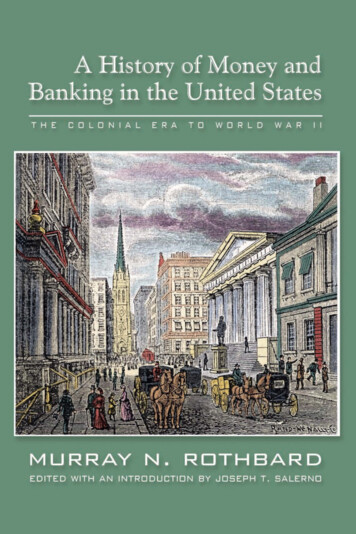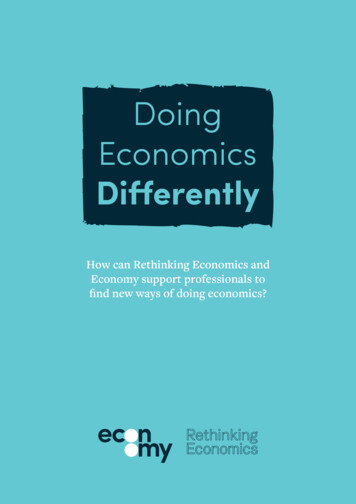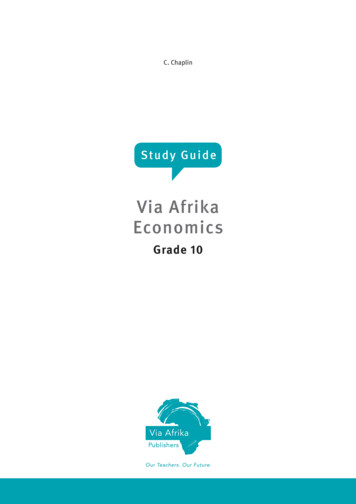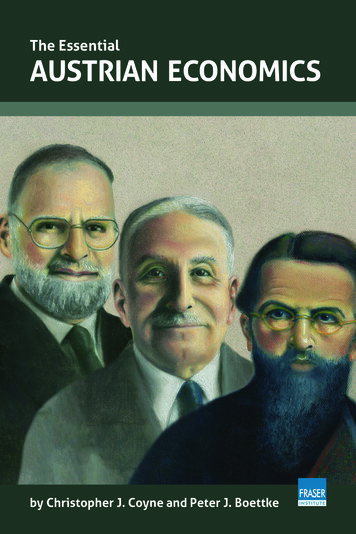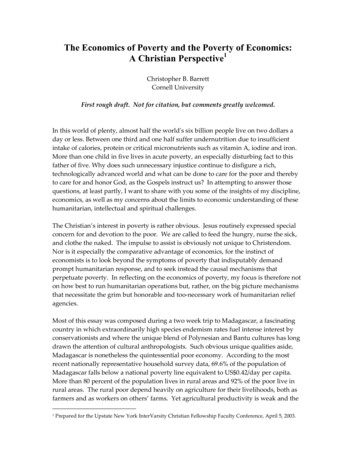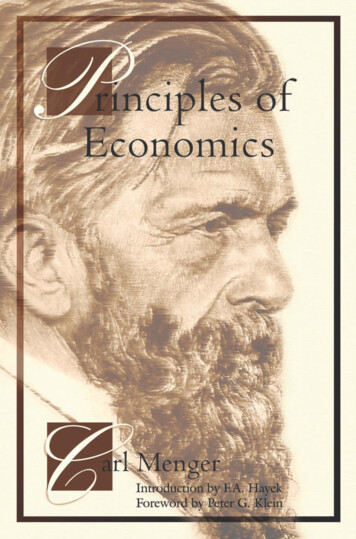
Transcription
PRINCIPLES OFECONOMICSCarl MengerFOREWORD BY PETER G. KLEININTRODUCTION BY F.A. HAYEKTRANSLATED BYJAMES DINGWALL AND BERT F. HOSELITZLudwigvon MisesInstituteAUBURN, ALABAMA
Cover: Carl Menger portrait is courtesy of The Warren J. Samuels PortraitCollection at Duke University.Copyright 1976 by the Institute for Humane StudiesForeword Copyright 2007 by the Ludwig von Mises InstituteReprinted in 2007 by the Ludwig von Mises InstituteLudwig von Mises Institute518 West Magnolia AvenueAuburn, Ala. 36832 U.S.A.www.mises.orgISBN: 978-1-933550-12-1
CONTENTSFOREWORD BY PETER G. KLEIN . . . . . . . . . . . . . . . . . . . . . . . . . . . . . . . . . . 7INTRODUCTION BY F.A. HAYEK . . . . . . . . . . . . . . . . . . . . . . . . . . . . . . . . . . 11TRANSLATOR’S PREFACE . . . . . . . . . . . . . . . . . . . . . . . . . . . . . . . . . . . . . . . . 37AUTHOR’S PREFACE. . . . . . . . . . . . . . . . . . . . . . . . . . . . . . . . . . . . . . . . . . . . . 45I. THE GENERAL THEORY OF THE GOOD. . . . . . . . . . . . . . . . . . . . . . . . .511. The Nature of Goods . . . . . . . . . . . . . . . . . . . . . . . . . . . . . . . . . . . . . . . .2. The Causal Connections between Goods . . . . . . . . . . . . . . . . . . . . . . . . .3. The Laws Governing Goods-Character . . . . . . . . . . . . . . . . . . . . . . . . . .515558A. The Goods-Character of Goods of HigherOrder is Dependent on Command ofCorresponding Complementary Goods . . . . . . . . . . . . . . . . . . . . . . .B. The Goods-Character of Goods of HigherOrder is Derived from that of theCorresponding Goods of Lower Order . . . . . . . . . . . . . . . . . . . . . . .634. Time and Error . . . . . . . . . . . . . . . . . . . . . . . . . . . . . . . . . . . . . . . . . . . . .5. The Causes of Progress in Human Welfare . . . . . . . . . . . . . . . . . . . . . . .6. Property. . . . . . . . . . . . . . . . . . . . . . . . . . . . . . . . . . . . . . . . . . . . . . . . . . .677174II. ECONOMY AND ECONOMIC GOODS . . . . . . . . . . . . . . . . . . . . . . . . . . .771. Human Requirements . . . . . . . . . . . . . . . . . . . . . . . . . . . . . . . . . . . . . . . .8058A. Requirements for Goods of First Order(Consumption Goods) . . . . . . . . . . . . . . . . . . . . . . . . . . . . . . . . . . . . 80B. Requirements for Goods of Higher Order(Means of Production) . . . . . . . . . . . . . . . . . . . . . . . . . . . . . . . . . . . . 84C. The Time Limits within Which Human Needs are Felt . . . . . . . . . . 872. The Available Quantities. . . . . . . . . . . . . . . . . . . . . . . . . . . . . . . . . . . . . . 893. The Origin of Human Economy and Economic Goods . . . . . . . . . . . . . . 94A. Economic Goods . . . . . . . . . . . . . . . . . . . . . . . . . . . . . . . . . . . . . . . . 94B. Non-Economic Goods . . . . . . . . . . . . . . . . . . . . . . . . . . . . . . . . . . . . 98C. The Relationship between Economic andNon-Economic Goods . . . . . . . . . . . . . . . . . . . . . . . . . . . . . . . . . . . . 101D. The Laws Governing the EconomicCharacter of Goods . . . . . . . . . . . . . . . . . . . . . . . . . . . . . . . . . . . . . . 1064. Wealth . . . . . . . . . . . . . . . . . . . . . . . . . . . . . . . . . . . . . . . . . . . . . . . . . . . . 1093
4PRINCIPLES OF ECONOMICSIII. THE THEORY OF VALUE . . . . . . . . . . . . . . . . . . . . . . . . . . . . . . . . . . . . . . 1141. The Nature and Origin of Value . . . . . . . . . . . . . . . . . . . . . . . . . . . . . . . . 1142. The Original Measure of Value . . . . . . . . . . . . . . . . . . . . . . . . . . . . . . . . 121A. Differences in the Magnitude of Importanceof Different Satisfactions (Subjective Factor) . . . . . . . . . . . . . . . . . .B. The Dependence of Separate Satisfactionson Particular Goods (Objective Factor) . . . . . . . . . . . . . . . . . . . . . . .C. The Influence of Differences in the Qualityof Goods on Their Value . . . . . . . . . . . . . . . . . . . . . . . . . . . . . . . . . .D. The Subjective Character of the Measureof Value. Labor and Value. Error . . . . . . . . . . . . . . . . . . . . . . . . . . . .3. The Laws Governing the Value of Goods of Higher Order . . . . . . . . . . .A. The Principle Determining the Value ofGoods of Higher Order . . . . . . . . . . . . . . . . . . . . . . . . . . . . . . . . . . .B. The Productivity of Capital . . . . . . . . . . . . . . . . . . . . . . . . . . . . . . . .C. The Value of Complementary Quantitiesof Goods of Higher Order . . . . . . . . . . . . . . . . . . . . . . . . . . . . . . . . .D. The Value of Individual Goods of Higher Order. . . . . . . . . . . . . . . .E. The Value of the Services of Land, Capital,and Labor in Particular. . . . . . . . . . . . . . . . . . . . . . . . . . . . . . . . . . . .122128141145149149152157162165IV. THE THEORY OF EXCHANGE . . . . . . . . . . . . . . . . . . . . . . . . . . . . . . . . . 1751. The Foundations of Economic Exchange. . . . . . . . . . . . . . . . . . . . . . . . . 1752. The Limits of Economic Exchange . . . . . . . . . . . . . . . . . . . . . . . . . . . . . 181V. THE THEORY OF PRICE . . . . . . . . . . . . . . . . . . . . . . . . . . . . . . . . . . . . . . . 1911. Price Formation in an Isolated Exchange. . . . . . . . . . . . . . . . . . . . . . . . . 1942. Price Formation under Monopoly . . . . . . . . . . . . . . . . . . . . . . . . . . . . . . 197A. Price Formation and the Distribution of Goods WhenThere is Competition Between Several Personsfor a Single Indivisible Monopolized Good. . . . . . . . . . . . . . . . . . . .B. Price Formation and the Distribution of GoodsWhen There is Competition for Several Unitsof a Monopolized Good . . . . . . . . . . . . . . . . . . . . . . . . . . . . . . . . . . .C. The Influence of the Price Fixed by a Monopoliston the Quantity of a Monopolized Good that Canbe Sold and on the Distribution of the GoodAmong the Competitors For It . . . . . . . . . . . . . . . . . . . . . . . . . . . . . .D. The Principles of Monopoly Trading (The Policyof a Monopolist) . . . . . . . . . . . . . . . . . . . . . . . . . . . . . . . . . . . . . . . . .1992032072113. Price Formation and the Distribution of Goodsunder Bilateral Competition . . . . . . . . . . . . . . . . . . . . . . . . . . . . . . . . . . . 216A. The Origin of Competition. . . . . . . . . . . . . . . . . . . . . . . . . . . . . . . . . 216B. The Effect of the Quantities of a CommoditySupplied by Competitors on Price Formation;
CONTENTS5the Effect of Given Prices Set by Them on Sales;and in Both Cases the Effect on the Distributionof the Commodity Among the Competing Buyers . . . . . . . . . . . . . . 218C. The Effect of Competition in the Supply of aGood on the Quantity Sold and on the Priceat which it is Offered (the Policiesof Competitors) . . . . . . . . . . . . . . . . . . . . . . . . . . . . . . . . . . . . . . . . . 220VI. USE VALUE AND EXCHANGE VALUE . . . . . . . . . . . . . . . . . . . . . . . . .A. The Nature of Use Value and Exchange Value . . . . . . . . . . . . . . . . .B. The Relationship Between the Use Valueand the Exchange Value of Goods . . . . . . . . . . . . . . . . . . . . . . . . . .C. Changes in the Economic Center of Gravityof the Value of Goods . . . . . . . . . . . . . . . . . . . . . . . . . . . . . . . . . . . .226226VII. THE THEORY OF THE COMMODITY . . . . . . . . . . . . . . . . . . . . . . . . . . .1. The Concept of the Commodity in its Popularand Scientific Meanings . . . . . . . . . . . . . . . . . . . . . . . . . . . . . . . . . . . . .2. The Marketability of Commodities . . . . . . . . . . . . . . . . . . . . . . . . . . . . .A. The Outer Limits of the Marketabilityof Commodities . . . . . . . . . . . . . . . . . . . . . . . . . . . . . . . . . . . . . . . . .B. The Different Degrees of Marketabilityof Commodities . . . . . . . . . . . . . . . . . . . . . . . . . . . . . . . . . . . . . . . . .C. The Facility with which Commodities Circulate. . . . . . . . . . . . . . . .236VIII. THE THEORY OF MONEY . . . . . . . . . . . . . . . . . . . . . . . . . . . . . . . . . . . .1. The Nature and Origin of Money . . . . . . . . . . . . . . . . . . . . . . . . . . . . . .2. The Kinds of Money Appropriate to Particular Peoplesand to Particular Historical Periods . . . . . . . . . . . . . . . . . . . . . . . . . . . .3. Money as a “Measure of Price” and as the MostEconomic Form for Storing Exchangeable Wealth. . . . . . . . . . . . . . . . .4. Coinage . . . . . . . . . . . . . . . . . . . . . . . . . . . . . . . . . . . . . . . . . . . . . . . . . .257257APPENDICES . . . . . . . . . . . . . . . . . . . . . . . . . . . . . . . . . . . . . . . . . . . . . . . . . . . .A. Goods and “Relationships” . . . . . . . . . . . . . . . . . . . . . . . . . . . . . . . .B. Wealth. . . . . . . . . . . . . . . . . . . . . . . . . . . . . . . . . . . . . . . . . . . . . . . . .C. The Nature of Value . . . . . . . . . . . . . . . . . . . . . . . . . . . . . . . . . . . . . .D. The Measure of Value . . . . . . . . . . . . . . . . . . . . . . . . . . . . . . . . . . . .E. The Concept of Capital . . . . . . . . . . . . . . . . . . . . . . . . . . . . . . . . . . .F. Equivalence in Exchange. . . . . . . . . . . . . . . . . . . . . . . . . . . . . . . . . .G. Use Value and Exchange Value . . . . . . . . . . . . . . . . . . . . . . . . . . . . .H. The Commodity Concept. . . . . . . . . . . . . . . . . . . . . . . . . . . . . . . . . .I. Designations for Money. . . . . . . . . . . . . . . . . . . . . . . . . . . . . . . . . . .J. History of Theories of the Origin of Money . . . . . . . . . . . . . . . . . . 48254262272280INDEX. . . . . . . . . . . . . . . . . . . . . . . . . . . . . . . . . . . . . . . . . . . . . . . . . . . . . . . . . . 321
FOREWORDBY PETER G. KLEIN“There never lived at the same time,” wrote Ludwig von Mises, “more thana score of men whose work contributed anything essential to economics.”1One of those men was Carl Menger (1840–1921), professor of politicaleconomy at the University of Vienna and founder of the Austrian School ofeconomics. Menger’s pathbreaking Grundsätze der Volkswirtschaftslehre(Principles of economics), published in 1871, not only introduced the concept of marginal analysis, it presented a radically new approach to economicanalysis, an approach that still forms the core of the Austrian theory of valueand price.Unlike his contemporaries William Stanley Jevons and Léon Walras, whoindependently developed their own concepts of marginal utility during the1870s, Menger favored an approach that was deductive, teleological, and, in aprimary sense, humanistic. While Menger shared his contemporaries’ preference for abstract reasoning, he was primarily interested in explaining the realworld actions of real people, not in creating artificial, stylized representationsof reality. Economics, for Menger, is the study of purposeful human choice,the relationship between means and ends. “All things are subject to the law ofcause and effect,” he begins his treatise. “This great principle knows no exception.”2 Jevons and Walras rejected cause and effect in favor of simultaneousdetermination, the technique of modeling complex relations as systems ofsimultaneous equations in which no variable “causes” another. Theirs hasbecome the standard approach in contemporary economics, accepted by nearlyall economists but the followers of Carl Menger.Menger sought to explain prices as the outcome of the purposeful, voluntary interactions of buyers and sellers, each guided by their own subjectiveevaluations of the usefulness of various goods and services (what we now callmarginal utility, a term later coined by Friedrich von Wieser). Trade is thus theresult of people’s deliberate attempts to improve their well-being, not an innate1. Ludwig von Mises, Human Action: A Treatise on Economics, Scholar’s Edition (Auburn,Ala.: Mises Institute, 1998), p. 869.2. This volume, p. 51.7
8PRINCIPLES OF ECONOMICS“propensity to truck, barter, and exchange,” as suggested by Adam Smith.3 Theexact quantities of goods exchanged—their prices, in other words—are determined by the values individuals attach to marginal units of these goods. With asingle buyer and seller, goods are exchanged as long as participants can agreeon an exchange ratio that leaves each better off than he was before. In a market with many buyers and sellers, the price reflects the valuations of the buyerleast willing to buy and the seller least willing to sell, what Böhm-Bawerkwould call the “marginal pairs.” Regardless of the exact structure of the market, then, voluntary exchange takes place until the gains from trade are momentarily exhausted. Menger’s highly general explanation of price formation continues to form the core of Austrian microeconomics.Menger’s approach has been labeled “causal-realistic,” partly to emphasize its differences with the mainstream, neoclassical approach. Besides itsfocus on causal relations, Menger’s analysis is realistic in the sense that hesought not to develop formal models of hypothetical economic relationships,but to explain the actual prices paid every day in real markets. The classicaleconomists had explained that prices are the result of supply and demand, butthey lacked a satisfactory theory of valuation to explain buyers’ willingnessto pay for goods and services. Rejecting value subjectivism, the classicaleconomists tended to treat demand as relatively unimportant and concentrated on hypothetical “long-run” conditions, in which “objective” characteristics of goods—most importantly, their costs of production—would determine their prices. The classical economists also tended to group factors ofproduction into broad categories—land, labor, and capital—leaving themunable to explain the prices of discrete, heterogeneous units of these factors.Menger realized that the actual prices paid for goods and services reflect notsome objective, “intrinsic” characteristics, but rather the uses to which discrete units of goods and services can be put, as perceived, subjectively, byindividual buyers and sellers.The Principles was written as an introductory volume in a proposed multivolume work. Unfortunately, those later volumes were never written.Menger did not explicitly develop the concept of opportunity cost, he did notextend his analysis to explain the prices of the factors of production, and hedid not develop a theory of monetary calculation. Those advances wouldcome later from his students and disciples Eugen von Böhm-Bawerk,Friedrich von Wieser, J.B. Clark, Philip Wicksteed, Frank A. Fetter, Herbert3. Adam Smith, An Inquiry into the Nature and Causes of the Wealth of Nations [1776], R.H.Campbell, A.S. Skinner, and W.B. Todd, eds. (Indianapolis: LibertyClassics, 1981), book 1,p. 24.
FOREWORD9J. Davenport, Ludwig von Mises, and F.A. Hayek. Many of the most important ideas are implicit in Menger’s analysis, however. For example, his distinction among goods of lower and higher “orders,” referring to their place inthe temporal sequence of production, forms the heart of Austrian capital theory, one of its most distinctive and important elements. Indeed, Mengeremphasizes the passage of time throughout his analysis, an emphasis that hasnot yet made its way into mainstream economic theorizing.While most contemporary economics treatises are turgid and dull,Menger’s book is remarkably easy to read, even today. His prose is lucid, hisanalysis is logical and systematic, his examples clear and informative. ThePrinciples remains an excellent introduction to economic reasoning and, forthe specialist, the classic statement of the core principles of the AustrianSchool.As Hayek writes in his Introduction below, the significance of the AustrianSchool is “entirely due to the foundations laid by this one man.”4 However,while Menger is universally recognized as the Austrian School’s founder, hiscausal-realistic approach to price formation is not always appreciated, evenamong contemporary Austrian economists. Karen Vaughn, for example, characterizes Menger’s price theory as essentially neoclassical, arguing that his distinctive Austrian contribution is “his many references to problems of knowledge and ignorance, his discussions of the emergence and function of institutions, the importance of articulating processes of adjustment, and his many references to the progress of mankind.”5 These issues, which attracted considerable attention during the “Austrian revival” of the 1970s, appear in Menger’s1883 book Untersuchungen über die Methode der Socialwissenschaften undder politischen Oekonomie insbesondere (Investigations into the method of thesocial sciences with special reference to economics).6 They are largely absentfrom the Principles, however. The book that established the Austrian Schoolfocuses on the essence of value, exchange, and price, not disequilibrium, tacitknowledge, or radical subjectivism.Another remarkable feature of Menger’s contribution is that it appearedin German, while the approach then dominant in the German-speaking world4. F.A. Hayek, “Introduction” to Carl Menger, Principles of Economics (1976;Auburn, Ala.: Ludwig von Mises Institute), p. 12; and this volume.5. Karen I. Vaughn, Austrian Economics in America: The Migration of a Tradition(Cambridge: Cambridge University Press, 1994), pp. 18–19.6. Carl Menger, Investigations into the Method of the Social Sciences, with SpecialReference to Economics, Louis Schneider, ed., Francis J. Nock, trans. (New York:New York University Press, 1985).
10PRINCIPLES OF ECONOMICSwas that of the “younger” German Historical School, which eschewed theoretical analysis altogether in favor of inductive, ideologically driven, historical case studies. The most accomplished theoretical economists, the Britishclassicals such as J.S. Mill, were largely unknown to German-speaking writers. As Hayek notes below,In England the progress of economic theory only stagnated. In Germany a second generation of historical economists grew up who hadnot only never become really acquainted with the one well-developedsystem of theory that existed, but had also learnt to regard theoreticalspeculations of any sort as useless if not positively harmful.7Menger’s approach—haughtily dismissed by the leader of the GermanHistorical School, Gustav Schmoller, as merely “Austrian,” the origin of thatlabel—led to a renaissance of theoretical economics in Europe and, later, inthe United States.In short, the core concepts of contemporary Austrian economics—humanaction, means and ends, subjective value, marginal analysis, methodologicalindividualism, the time structure of production, and so on—along with theAustrian theory of value and price, which forms the heart of Austrian analysis, all flow from Menger’s pathbreaking work. As Joseph Salerno has written, “Austrian economics always was and will forever remain Mengerianeconomics.”8Peter G. KleinUniversity of Missouri7. Hayek, “Introduction,” p. 13; and this volume.8. Joseph T. Salerno, “Carl Menger: The Founder of the Austrian School,” in Randall G.Holcombe, ed., Fifteen Great Austrian Economists (Auburn, Ala.: Ludwig von MisesInstitute, 1999), p. 71.
INTRODUCTIONCARL MENGER1By F.A. HayekThe history of economics is full of tales of forgotten forerunners,men whose work had no effect and was only rediscovered aftertheir main ideas had been made popular by others, of remarkable coincidences of simultaneous discoveries, and of the peculiar fateof individual books. But there must be few instances, in economics orany other branch of knowledge, where the works of an author who revolutionised the body of an already well-developed science and who hasbeen generally recognised to have done so, have remained so little1This biographical study was written as an Introduction to the Reprint of Menger’sGrundsätze der Volkswirtschaftslehre which constitutes the first of a series of four Reprintsembodying Menger’s chief published contributions to Economic Science and whichwere published by the London School of Economics as Numbers 17 to 20 of its Series ofReprints of Scarce Works in Economics and Political Science.11
12 Principles of Economicsknown as those of Carl Menger. It is difficult to think of a parallel casewhere a work such as the Grundsätze has exercised a lasting and persistent influence but has yet, as a result of purely accidental circumstances, had so extremely restricted a circulation.There can be no doubt among competent historians that if, duringthe last sixty years, the Austrian School has occupied an almostunique position in the development of economic science, this isentirely due to the foundations laid by this one man. The reputationof the School in the outside world and the development of its systemat important points were due to the efforts of his brilliant followers,Eugen von Böhm-Bawerk and Friedrich von Wieser. But it is notunduly to detract from the merits of these writers to say that its fundamental ideas belong fully and wholly to Carl Menger. If he had notfound these principles he might have remained comparativelyunknown, might even have shared the fate of the many brilliant menwho anticipated him and were forgotten, and almost certainly wouldfor a long time have remained little known outside the countries of theGerman tongue. But what is common to the members of the AustrianSchool, what constitutes their peculiarity and provided the foundations for their later contributions is their acceptance of the teaching ofCarl Menger.The independent and practically simultaneous discovery of theprinciple of marginal utility by William Stanley Jevons, Carl Menger,and Léon Walras is too well known to require retelling. The year 1871,in which both Jevons’ Theory of Political Economy and Menger’s Grundsätze appeared, is now generally and with justice regarded as thebeginning of the modern period in the development of economics.Jevons had outlined his fundamental ideas nine years earlier in a lecture (published in 1866) which, however, attracted little attention, andWalras began to publish his contribution only in 1874, but the complete independence of the work of the three founders is quite certain.And indeed, although their central positions, the point in their systemto which they and their contemporaries naturally attached the greatest importance, are the same, their work is so clearly distinct in general character and background that the most interesting problem isreally how so different routes should have led to such similar results.To understand the intellectual background of the work of CarlMenger, a few words on the general position of economics at that timeare required. Although the quarter of a century between about 1848,the date of J.S. Mill’s Principles, and the emergence of the new schoolsaw in many ways the greatest triumphs of the classical politicaleconomy in the applied fields, its foundations, particularly its theory
Introduction 13of value, had become more and more discredited. Perhaps the systematic exposition in J.S. Mill’s Principles itself, in spite or because ofhis complacent satisfaction about the perfected state of the theory ofvalue, together with his later retractions on other essential points ofthe doctrine, did as much as anything else to show the deficiencies ofthe classical system. In any case, critical attacks and attempts at reconstruction multiplied in most countries.Nowhere, however, had the decline of the classical school of economists been more rapid and complete than in Germany. Under theonslaughts of the Historical School not only were the classical doctrines completely abandoned—they had never taken very firm root inthat part of the world—but any attempt at theoretical analysis came tobe regarded with deep distrust. This was partly due to methodological considerations. But even more it was due to an intense dislike ofthe practical conclusions of the classical English School—which stoodin the way of the reforming zeal of the new group which prided itselfon the name of the “ethical school.” In England the progress of economic theory only stagnated. In Germany a second generation of historical economists grew up who had not only never become reallyacquainted with the one well-developed system of theory that existed,but had also learnt to regard theoretical speculations of any sort asuseless if not positively harmful.The doctrines of the classical school were probably too much discredited to provide a possible basis of reconstruction for those whowere still interested in problems of theory. But there were elements inthe writings of the German economists of the first half of the centurywhich contained the germs for a possible new development.1 One ofthe reasons why the classical doctrines had never firmly establishedthemselves in Germany was that German economists had alwaysremained conscious of certain contradictions inherent in any cost or,labour theory of value. Owing, perhaps, partly to the influence ofCondillac and other French and Italian authors of the eighteenth century a tradition had been kept alive which refused to separate valueentirely from utility. From the early years of the century into the‘fifties and ‘sixties a succession of writers, of whom Hermann wasprobably the outstanding and most influential figure (the wholly successful Gossen remaining unnoticed), tried to combine the ideas ofutility and scarcity into an explanation of value, often coming very1The same is largely true of France. Even in England there was a kind of unorthodox tradition, of which the same may be said, but it was completely obscured by thedominant classical school. It is, however, important here because the work of its outstanding representative, Longfield, had through the intermediary ship of Hearn nodoubt some influence on Jevons.
14 Principles of Economicsnear to the solution provided by Menger. It is to these speculations,which to the more practical minds of the contemporary English economists must have appeared useless excursions into philosophy, thatMenger owed most. A glance through the extensive footnotes in hisGrundsätze, or the author’s index which has been added to the presentedition, will show how extraordinarily wide a knowledge he possessed of these German authors and also of the French and Italianwriters, and how small a role the writers of the classical English schoolplays in comparison.But while Menger probably surpassed all his fellow-founders of themarginal utility doctrine in the width of his knowledge of the literature—and only from a passionate book collector inspired by the example of the encyclopaedic Roscher could one expect a similar knowledgeat the early age the Grundsätze was written—there are curious gaps inthe list of authors to whom he refers which go far to explain the difference of his approach from that of Jevons and Walras.1 Particularly significant is his apparent ignorance, at the time when he wrote the Grundsätze, of the work of Cournot, to whom all the other founders of modern economics, Walras, Marshall, and very possibly Jevons2, seem tohave been directly or indirectly indebted. Even more surprising, however, is the fact that at that time Menger does not seem to have knownthe work of von Thünen, which one would have expected him to findparticularly congenial. While it can be said, therefore, that he worked inan atmosphere distinctly favourable to an analysis on utility lines, hehad nothing so definite on which to build a modern theory of price ashis fellows in the same field, all of whom came under the influence ofCournot, to which must be added, in the case of Walras, that of Dupuit3and, in the case of Marshall, that of von Thünen.It is an interesting speculation to think what direction the development of Menger’s thought would have taken if he had beenacquainted with these founders of mathematical analysis. It is a curious1It is hardly surprising that he did not know his immediate German predecessorH.H. Gossen, but neither did Jevons or Walras when they first published their ideas.The first book which did justice at all to Gossen’s work, F.A. Lange’s Arbeiterfrage (2nded.), appeared in 1870 when Menger’s Grundsätze was probably already being set up inprint.2Dr. Hicks tells me that he has some reason to believe that Lardner’s diagrammaticexposition of the theory of monopoly, by which Jevons according to his own testimony wasmainly influenced, derives from Cournot. On this point see Dr. Hicks’s article on Léon Walras which is to appear in one of the next issues of Econometrica.3Menger did, however, know the work of Léon Walras’s father, A.A.Walras, whomhe quotes on p. 54 of the Grundsätze.
Introduction 15fact that, so far as I am aware, he has nowhere commented on thevalue of mathematics as a tool of economic analysis. There is no reason to assume that he lacked either the technical equipment or theinclination. On the contrary, his interest in the natural sciences isbeyond doubt, and a strong bias in favour of their methods is evidentthroughout his work. And the fact that his brothers, particularlyAnton, are known to have been intensely interested in mathematics,and that his son Karl became a noted mathematician, may probably betaken as evidence of a definite mathematical strain in the family. Butalthough he knew later not only the work of Jevons and Walras, butalso that of his compatriots Auspitz and Lieben, he does not even referto the mathematical method in any of his writings on methodology.1Must we conclude that he felt rather sceptical about its usefulness?Among the influences to which Menger must have been subjectduring the formative period of his thought there is a complete absenceof influence of Austrian economists, for the simple reason that, in theearlier part of the nineteenth century in Austria, there were practicallyno native economists. At the universities where Menger studied, political economy was
Adam Smith, An Inquiry into the Nature and Causes of the Wealth of Nations[1776], R.H. Campbell, A.S. Skinner, and W.B. Todd, eds. (Indianapolis: LibertyClassics, 1981), book 1, p. 24. 8 PRINCIPLES OF ECONOMICS “propensity to truck, barter, and exchange,” as suggested by Adam Smith. 3 The exact quantities o


